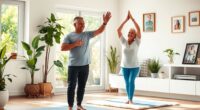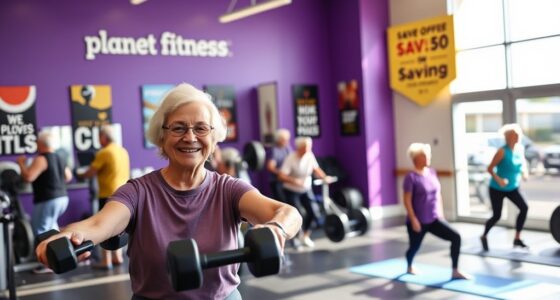Senior workout classes can greatly improve your health, boost your energy, and connect you with others. You’ll find tailored exercises for every ability, helping you build strength, stability, and flexibility safely. Plus, the social interaction offers motivation and combats loneliness. Staying engaged in these classes can enhance your overall well-being while monitoring your health becomes easier. You won’t want to miss the incredible benefits waiting for you, and there’s so much more to discover about these transformative experiences.
Key Takeaways
- Senior workout classes enhance physical health, reducing chronic disease risk and improving overall quality of life.
- Tailored exercises accommodate all fitness levels, ensuring safety and effectiveness for every participant.
- Regular participation boosts strength, flexibility, and mobility, aiding in daily tasks and independence.
- Group workouts foster social connections, combating loneliness and improving mental health.
- Classes promote a supportive environment, encouraging hydration and awareness of personal limits to prevent injuries.
The Benefits of Senior Workout Classes
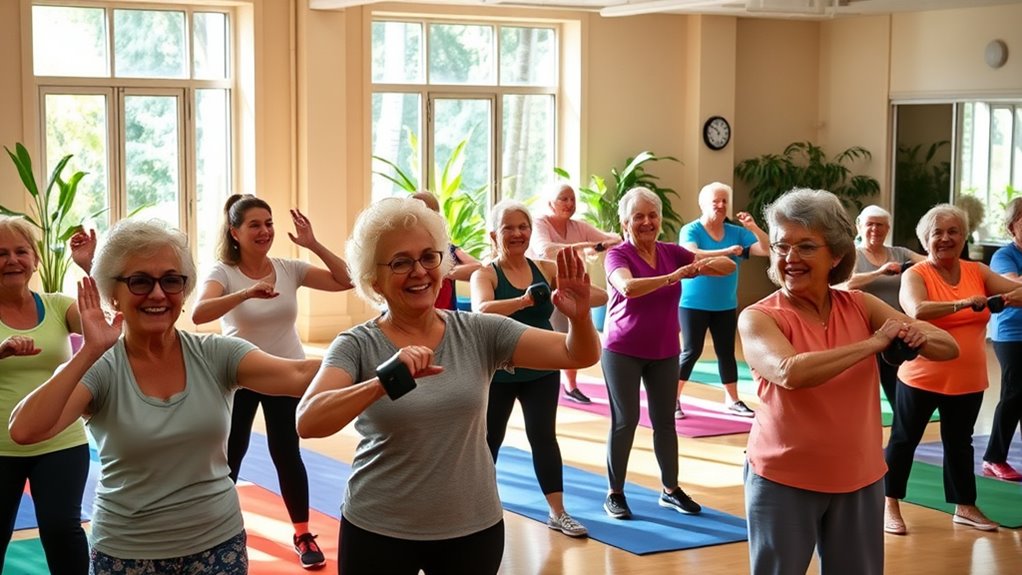
When you participate in senior workout classes, you’re not just staying active—you’re also investing in your overall well-being.
These classes can greatly improve your physical health by reducing the risk of chronic diseases and enhancing cardiovascular fitness. You’ll also foster social connections, which help combat loneliness and boost mental health. Engaging in regular physical activity can also help manage behavioral issues that some seniors may experience. Additionally, consistent self-care routines can further enhance the benefits of these workouts. Incorporating flexibility and strength training can also lead to improved mobility and independence. Furthermore, understanding financial considerations regarding the costs of fitness classes can ensure you choose options that fit your budget.
Participating in senior workout classes enhances physical health, reduces chronic disease risk, and fosters valuable social connections.
Structured exercise enhances your balance and coordination, drastically lowering the likelihood of falls. Plus, many workouts focus on flexibility and strength, ensuring you maintain mobility and independence as you age.
Regular participation can even improve cognitive function and memory retention, aiding in the prevention of age-related decline. Additionally, transforming spaces for exercise can create a more enjoyable environment that encourages consistent participation.
Tailored Exercises for Every Ability

In senior workout classes, you’ll find inclusive movement modifications that cater to your unique fitness level. These tailored exercises allow you to progress at your own pace, ensuring you feel comfortable while challenging yourself. With personalized adjustments, you can enhance your fitness journey without compromising safety or effectiveness. Additionally, engaging in community feedback can help tailor classes to better suit individual needs and preferences. Incorporating appropriate safety precautions is essential to ensure a positive and effective workout experience for all participants. Furthermore, participating in regular exercise can significantly improve quality of life for seniors, promoting both physical and mental well-being. Research indicates that emotional support can also be beneficial in enhancing motivation and commitment to fitness routines. Moreover, the implementation of community collaboration in designing fitness programs can further enrich the overall experience and foster a sense of belonging among participants.
Inclusive Movement Modifications
Inclusive movement modifications in senior workout classes make it possible for everyone to participate, regardless of their health conditions or fitness levels. Instructors tailor exercises to accommodate individual needs, ensuring safety and engagement. For example, you might enjoy a nutritious meal like a Turkey Bean and Tomato Zoodle Bowl after your workout to replenish your energy. Practicing self-reflection can also help you identify which exercises work best for your unique abilities and preferences. Engaging in regular physical activity can enhance cognitive development and emotional well-being as you age.
You might use props like chairs or walls during balance exercises, providing essential support for strength and flexibility training. Movements such as squats or lunges can be adjusted in depth or with arm variations, maintaining proper form while minimizing risk. Regular interaction with diverse exercise styles can enhance adaptability and confidence in your routine.
Low-impact cardio exercises like step touches and knee lifts help you elevate your heart rate without injury, boosting cardiovascular health. Regular assessments of your comfort level, rated on a scale of one to ten, allow instructors to offer timely modifications and enhance your overall experience. Incorporating risk tolerance into your exercise routine can help you choose the right intensity for your fitness journey.
Personalized Fitness Progression
Tailored exercises in senior workout classes empower you to engage at your own pace and ability level, guaranteeing each session is both safe and effective. Instructors assess your unique health conditions and fitness levels, modifying movements like squats and lunges for those who need extra support or lower impact options. Studies show that pet therapy can enhance emotional well-being, making it a beneficial addition to your overall wellness routine. Additionally, cold medications can be helpful for seniors who may experience illness, ensuring they can participate in classes comfortably. Recognizing patterns of emotional detachment is crucial for maintaining motivation and connection during your fitness journey.
You’ll find a variety of movements, including punches, knee lifts, and hamstring curls, personalized to enhance your strength, balance, and cardio fitness based on your individual goals. Regular assessments help you track your progress and feelings during workouts, keeping you motivated and engaged. Plus, tailored stretching techniques guarantee you gain flexibility and mobility that suit your comfort level, making every class a rewarding experience. Additionally, maintaining a clean and organized home can further enhance your mental well-being, contributing to a more positive mindset as you pursue your fitness journey.
Building Strength and Stability
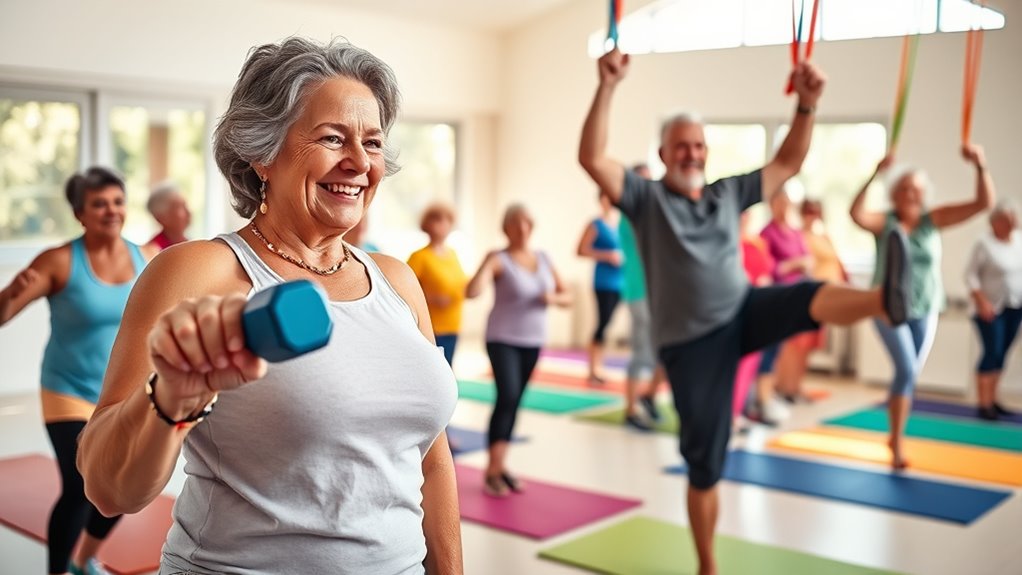
As you age, building strength and stability becomes essential for maintaining your independence and reducing the risk of falls, which affect one in four older adults each year.
Engaging in strength training exercises like squats and resistance movements enhances muscle mass and bone density, helping to combat age-related decline. Incorporating stability exercises, such as balance challenges and core engagement activities, improves your coordination and supports daily activities. Regularly practicing yoga poses can also contribute to improving balance and flexibility for seniors. Additionally, participating in regular strength training can lead to a significant 25-30% improvement in functional performance, making everyday tasks easier and safer. Research shows that foods rich in omega-3 fatty acids can also support cognitive function, which is crucial for maintaining overall well-being as you age. By focusing on vibrational alignment with youthfulness, you can enhance your overall energy and vitality as you engage in these workouts.
Strength training and stability exercises boost muscle mass, bone density, and coordination, essential for healthy aging and daily activities.
Regular strength and stability workouts lead to better mobility, increased energy levels, and an overall enhanced quality of life. Research shows that older adults who participate in regular strength training can experience a 25-30% improvement in functional performance, making everyday tasks easier and safer. Additionally, understanding emergency preparedness essentials can further enhance your confidence and resilience in daily living.
Don’t wait—start building your strength today!
Enhancing Flexibility and Mobility
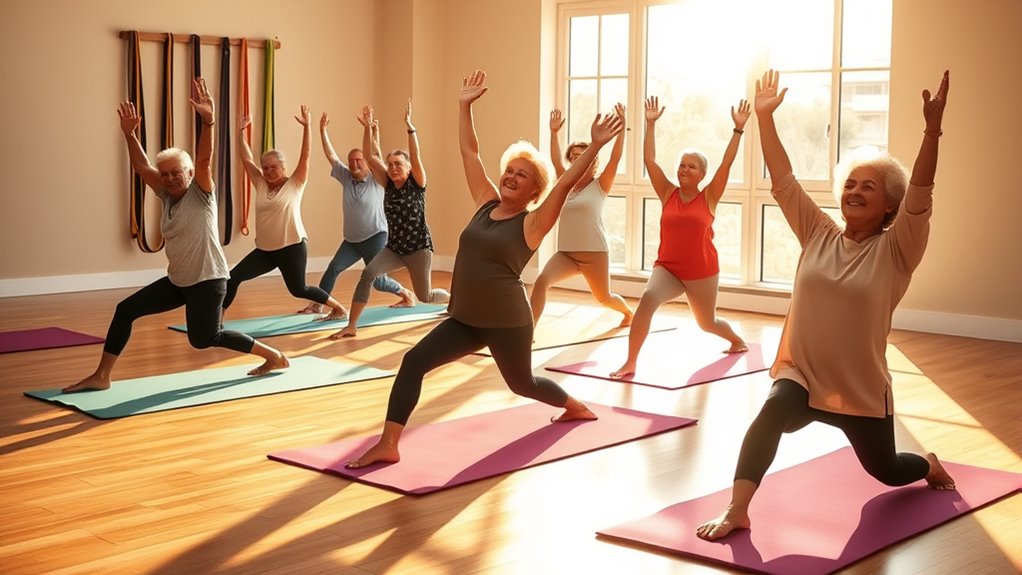
Stretching plays an essential role in enhancing your flexibility and mobility, helping you maintain your independence.
By focusing on balance and coordination, you can reduce the risk of falls and improve your overall stability.
Incorporating mobility-enhancing techniques into your routine not only boosts joint function but also supports your daily activities.
Importance of Stretching
Flexibility plays an essential role in maintaining mobility and independence as we age. Regular stretching can greatly improve your flexibility, making everyday tasks easier and reducing your risk of injury.
Engaging in these exercises not only increases blood circulation, delivering important nutrients to your muscles and joints, but also alleviates stiffness, which is critical for joint health.
- Stretching decreases muscle tension and enhances posture.
- It can reduce stress levels, promoting better mental health.
- Consistent stretching leads to improved range of motion, allowing for greater independence.
Balance and Coordination
Building on the benefits of stretching, balance and coordination exercises are essential for maintaining your mobility and reducing the risk of falls.
Movements like toe taps and pivot twists enhance your stability by improving proprioception and body awareness. Engaging in hamstring curls and gluteus lunges not only promotes flexibility but also supports your independence in daily activities.
If you’re concerned about safety, incorporating chair support during these exercises allows you to practice weight shifts and stability without risking injury.
Regular participation in balance workouts strengthens your muscles and joints, enhancing overall mobility and quality of life.
Don’t underestimate the importance of these exercises—embracing them now can make a significant difference in how you navigate the world as you age.
Mobility Enhancing Techniques
To maintain your independence and enhance mobility as you age, incorporating mobility-enhancing techniques into your routine is vital. These exercises greatly improve flexibility and range of motion, lowering your risk of injury.
Here are some effective techniques to take into account:
- Hip Circles & Ankle Rotations: These movements improve joint health and flexibility.
- Dynamic Stretches: Engage muscle groups with toe taps and gluteus lunges to boost circulation.
- Pivot Twists & Squats: Strengthen your core and improve balance, essential for daily activities.
Additionally, combining deep breathing with stretching promotes relaxation and increases blood flow, making movements smoother.
The Importance of Social Interaction
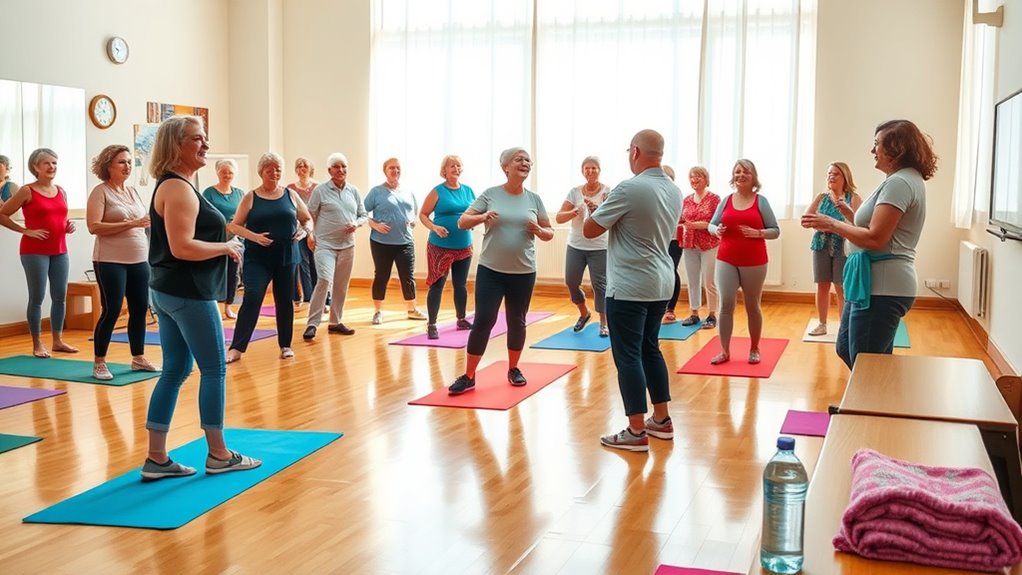
While engaging in senior workout classes primarily focuses on physical fitness, the importance of social interaction can’t be overstated. Connecting with peers during these workouts boosts your mental health, helping to reduce feelings of loneliness and depression.
You’ll find that exercising together improves motivation and adherence to your fitness routine, leading to better overall health. Plus, studies show that group activities can enhance cognitive function, stimulating your brain and sharpening memory and reasoning skills.
Participating in these classes also encourages communication, helping you maintain and build friendships that enrich your life. Ultimately, regular social interaction through fitness not only fosters a sense of community but can also lead to lower healthcare costs, as active seniors experience fewer health issues.
Monitoring Health and Well-Being
Monitoring your health and well-being during senior workout classes is essential for guaranteeing a safe and effective exercise experience. Staying aware of your physical limits helps prevent injuries while promoting overall health.
Regular physical activity can greatly improve your mental well-being, with studies indicating a 30% reduction in anxiety and depression symptoms among seniors who exercise consistently.
Consider these key practices:
- Assess your feelings on a scale of one to ten during workouts to gauge exertion levels.
- Stay hydrated by drinking water before, during, and after your workout.
- Modify movements based on your health conditions to guarantee safe participation.
Creating a Supportive Environment
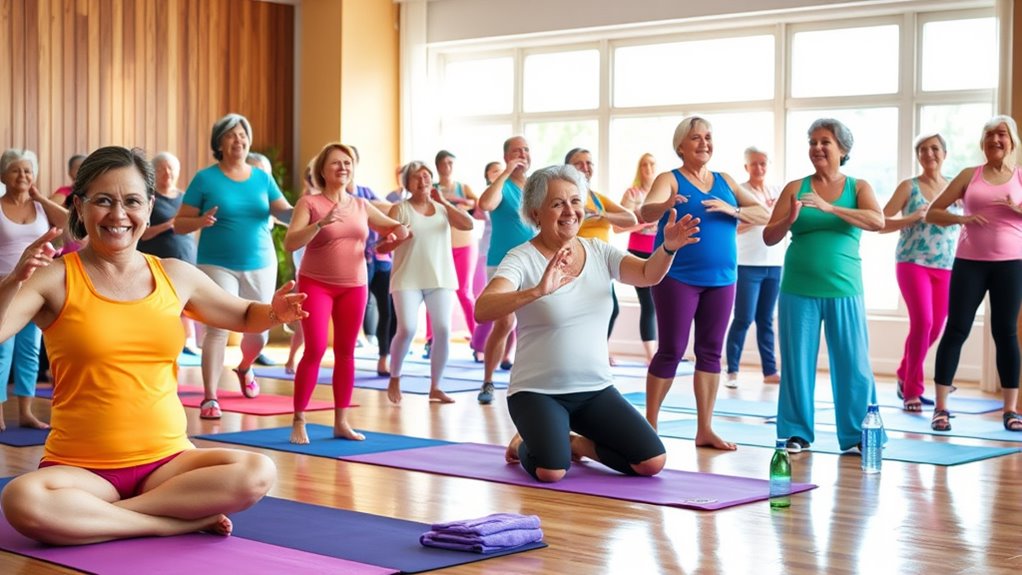
Creating a supportive environment in senior workout classes greatly enhances the exercise experience.
These classes focus on inclusivity, ensuring everyone feels welcome, regardless of fitness levels. Instructors, like Julie from the YMCA virtual studio, play an essential role in this by monitoring your feelings and offering modifications for any health conditions you might have.
Classes also encourage social connections, helping you build friendships and support networks that boost motivation. Safety is prioritized, with options for using supportive equipment like chairs during balance exercises, making you feel secure.
Regular hydration breaks and gentle reminders to listen to your body foster a respectful atmosphere, promoting both your physical and mental well-being throughout the workout.
Join in, and enjoy the positive vibes!
Staying Hydrated and Energized
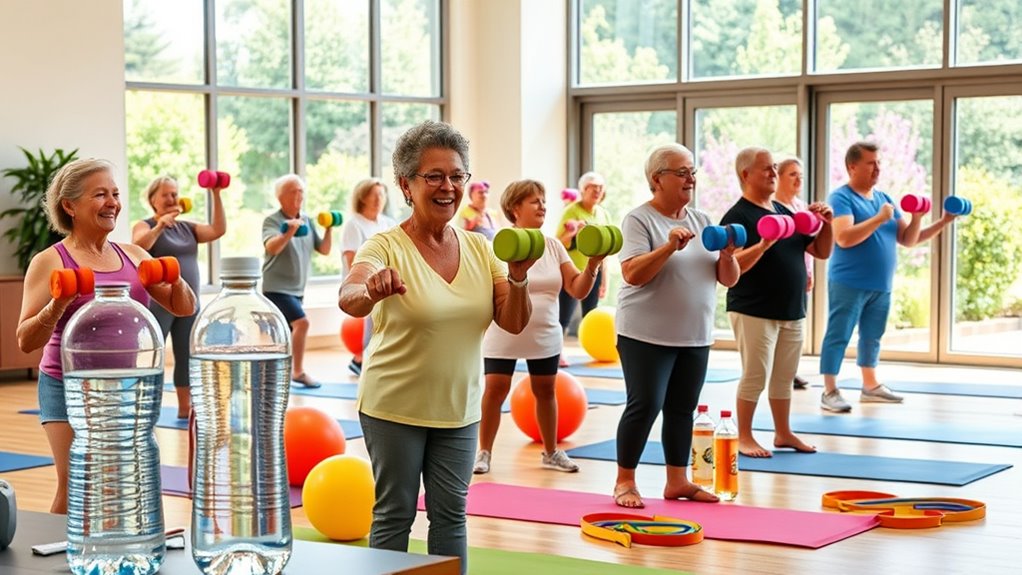
Staying properly hydrated and energized during your workout is essential for maintaining peak performance and preventing fatigue, especially as you age.
Even mild dehydration can hinder your workout, so make sure to drink water before, during, and after your sessions. Aim for at least 8-10 ounces every 20-30 minutes.
Consider these tips to enhance your hydration:
- Opt for electrolyte-rich beverages to replenish minerals lost through sweat.
- Monitor your urine color: light yellow means you’re well-hydrated, while darker shades indicate a need for more fluids.
- Incorporate hydrating foods like fruits and vegetables into your diet for added hydration and energy.
Frequently Asked Questions
What Is the Best Exercise Class for Seniors?
The best exercise class for seniors focuses on low-impact activities that enhance balance, strength, and flexibility.
Look for classes that offer modifications to accommodate different fitness levels, ensuring everyone can participate safely.
Incorporating social elements, like group activities and encouraging instructors, can make your experience enjoyable and motivating.
Regular attendance can greatly improve your cardiovascular health, muscle strength, and mental well-being, helping you lead a more active and fulfilling life.
What Is the Number One Exercise for Seniors?
The number one exercise for seniors is walking. It’s a low-impact activity that you can easily incorporate into your daily routine.
Walking improves your cardiovascular health, boosts mood, and enhances mobility and balance. If you aim for at least 150 minutes each week, you’ll notice significant improvements in muscle strength and endurance.
Plus, walking can connect you with others, reducing feelings of isolation while keeping your joints flexible and easing arthritis symptoms.
What Is the Number One Exercise to Increase Balance in Seniors?
The number one exercise to increase balance in seniors is the single-leg stand.
By practicing this simple yet effective move, you’ll challenge your stability and strengthen your legs. Just holding the position for 10 seconds on each leg, three times a week, can greatly enhance your balance and reduce the risk of falls.
Incorporating this exercise into your routine boosts your confidence and helps you stay active in daily life.
Give it a try!
How Many Times a Week Should a 70 Year Old Go to the Gym?
You might think going to the gym every day is necessary for fitness, but that’s not the case for a 70-year-old.
Aim for at least three to five times a week, focusing on a mix of aerobic, strength, and flexibility exercises.
This balanced approach keeps your workouts enjoyable and effective while promoting overall health.
Always listen to your body, and adjust your routine based on how you feel and any medical advice you receive.
Conclusion
Joining senior workout classes brings boundless benefits, boosting your body and spirit. You’ll build strength, enhance flexibility, and forge friendships that flourish. With tailored exercises and a supportive setting, you can stay safe while aiming for your health goals. So don’t delay—dive into dynamic workouts today! Embrace this empowering experience and discover how staying active can transform your life. You’ll wish you’d jumped in sooner and started savoring the splendid rewards of movement!


